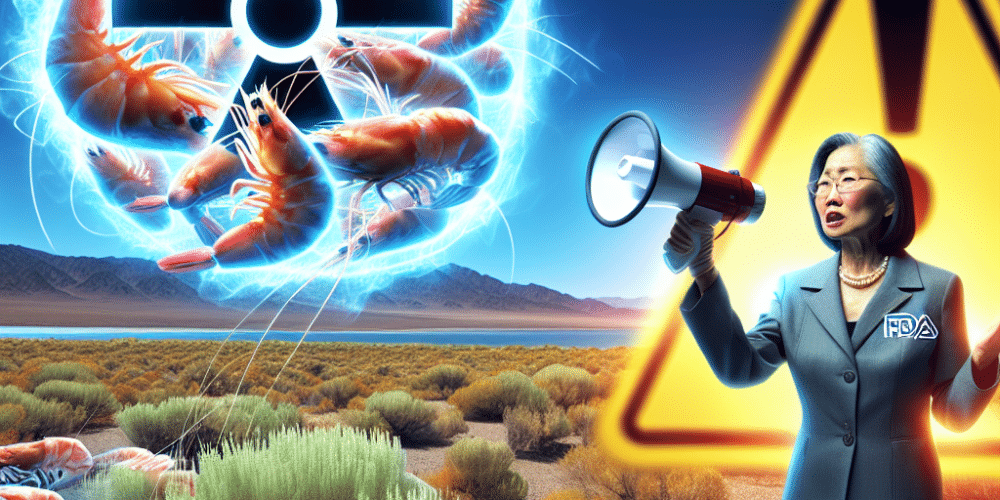In a startling development, the Food and Drug Administration (FDA) has issued an urgent alert regarding shrimp purchased from Kroger stores in Nevada, specifically between June and September of this year. Consumers who acquired shrimp during this time period may be dealing with a radioactive threat, as over 85,000 bags of shrimp have been recalled due to potential contamination with cesium-317, a radioactive isotope generated through nuclear fission.
The contamination involves three types of shrimp that, unbeknownst to many, may have been exposed to this hazardous element. Cesium-317 is no trivial matter; its presence in food products is alarming due to the severe health risks it poses. Consumers are now facing the grim possibility of burns, radiation sickness, and even an increased risk of cancer from potential exposure to this isotope. The reality of such a risk underscores the gravity of the FDA’s warning.
The FDA’s investigation is ongoing, as the source of the contamination remains unclear. The agency has speculated that the shrimp may have been “prepared, packed, or held under insanitary conditions,” leading to the contamination with cesium-137, another radioactive variant of cesium often found in nuclear fallout. This unsettling speculation has raised serious concerns about food safety protocols and the potential for similar incidents in the future.
Kroger stores, where the affected shrimp were sold, have begun a recall of the Aquastar brand shrimp, which were available from June 12 to September 17. The swift recall is a critical step to mitigate the health risks, yet it also highlights the challenges consumers face in ensuring the safety of their purchased goods. The situation has left many Nevada residents uneasy, questioning the safety measures in place for the fish and seafood products they regularly consume.
The incident is reminiscent of previous occurrences of radioactive contamination in the seafood industry. The FDA has had to recall shrimp in the past, notably from Indonesia, due to similar issues. Such incidents raise questions about the integrity of international supply chains and the rigorousness of inspections designed to protect consumers. The globalized nature of food sourcing means that contamination in one part of the world can quickly become a health concern in another.
A spokesperson close to the investigation expressed concerns about the recurrence of such contamination events, suggesting that, while rare, these incidents are reminders of the complex and interconnected nature of modern food systems. The need for stringent safety checks and international collaboration on food safety standards has never been more apparent.
Despite the recall and the FDA’s ongoing efforts to identify the contamination source, some consumers remain skeptical and anxious. They argue that without a clear understanding of how the contamination occurred, similar incidents could happen again, leaving them vulnerable to unseen dangers. This viewpoint underscores a critical debate about the balance between maintaining affordable food supplies and ensuring rigorous safety standards.
On the other side of the argument, some industry experts emphasize the rarity of such contamination issues and the overall robustness of current food safety measures. They argue that while the situation is serious, it should be viewed in the context of the millions of safe food transactions that occur daily without incident. According to these experts, the recall process, though alarming, is evidence of a system that works to identify and address issues promptly.
As of now, the FDA continues to work closely with Kroger and other relevant authorities to trace back the contamination’s origins and prevent similar future occurrences. Meanwhile, consumers are advised to check their shrimp purchases and dispose of any potentially contaminated products. The FDA’s warning remains in place, stressing the importance of consumer vigilance when it comes to food safety.
For Nevada residents, this incident serves as a stark reminder of the hidden complexities in their grocery shopping. The unexpected intersection of nuclear science and seafood in their daily lives has underscored the critical need for transparent and effective food safety systems. As one local resident might reflect, ensuring the food on the table is safe to eat is a responsibility shared by producers, regulators, and consumers alike.
Ultimately, the radioactive shrimp scare has exposed vulnerabilities in the food safety net and sparked a call for improved practices and safeguards. The hope is that through continued vigilance and systemic improvements, such hazardous surprises can be effectively minimized, ensuring that what ends up on the dinner plate is not only delicious but also safe to consume.

David Garato is a luminary in gaming journalism, renowned for peeling back the curtain on the gaming world with his witty and insightful commentary. A decade into weaving stories from the pixelated edges of indie games to the expansive universes of AAA titles, David’s work is a thrilling blend of analysis and adventure. When not writing, he’s live-streaming, sharing his gaming exploits with an engaged and growing audience. David doesn’t just write about games; he lives them, making him a trusted guide in the gaming community.
















